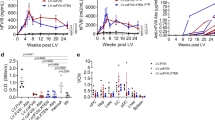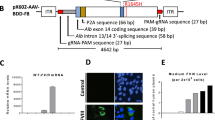Abstract
Current therapies for hemophilia A include frequent prophylactic or on-demand intravenous factor treatments which are costly, inconvenient and may lead to inhibitor formation. Viral vector delivery of factor VIII (FVIII) cDNA has the potential to alleviate the debilitating clotting defects. Lentiviral-based vectors delivered to murine models of hemophilia A mediate phenotypic correction. However, a limitation of lentiviral-mediated FVIII delivery is inefficient transduction of target cells. Here, we engineer a feline immunodeficiency virus (FIV) -based lentiviral vector pseudotyped with the baculovirus GP64 envelope glycoprotein to mediate efficient gene transfer to mouse hepatocytes. In anticipation of future studies in FVIII-deficient dogs, we investigated the efficacy of FIV-delivered canine FVIII (cFVIII). Codon-optimization of the cFVIII sequence increased activity and decreased blood loss as compared to the native sequence. Further, we compared a standard B-domain deleted FVIII cDNA to a cDNA including 256 amino acids of the B-domain with 11 potential asparagine-linked oligosaccharide linkages. Restoring a partial B-domain resulted in modest reduction of endoplasmic reticulum (ER) stress markers. Importantly, our optimized vectors achieved wild-type levels of phenotypic correction with minimal inhibitor formation. These studies provide insights into optimal design of a therapeutically relevant gene therapy vector for a devastating bleeding disorder.
This is a preview of subscription content, access via your institution
Access options
Subscribe to this journal
Receive 12 print issues and online access
$259.00 per year
only $21.58 per issue
Buy this article
- Purchase on Springer Link
- Instant access to full article PDF
Prices may be subject to local taxes which are calculated during checkout





Similar content being viewed by others
References
Hoyer LW . Hemophilia A. N Engl J Med 1994; 330: 38–47.
Rosendaal FR, Smit C, Briet E . Hemophilia treatment in historical perspective: a review of medical and social developments. Ann Hematol 1991; 62: 5–15.
Kaufman RJ . Advances toward gene therapy for hemophilia at the millennium. Hum Gene Ther 1999; 10: 2091–2107.
Chuah MK, Collen D, VandenDriessche T . Gene therapy for hemophilia. J Gene Med 2001; 3: 3–20.
Hoyer LW . Why do so many haemophilia A patients develop an inhibitor? Br J Haematol 1995; 90: 498–501.
Qian J, Borovok M, Bi L, Kazazian Jr HH, Hoyer LW . Inhibitor antibody development and T cell response to human factor VIII in murine hemophilia A. Thromb Haemost 1999; 81: 240–244.
Fakharzadeh SS, Kazazian HH Jr . Correlation between factor VIII genotype and inhibitor development in hemophilia A. Semin Thromb Hemost 2000; 26: 167–171.
Fakharzadeh SS, Zhang Y, Sarkar R, Kazazian HH Jr . Correction of the coagulation defect in hemophilia A mice through factor VIII expression in skin. Blood 2000; 95: 2799–2805.
Sarkar R, Xiao W, Kazazian HH Jr. . A single adeno-associated virus (AAV)-murine factor VIII vector partially corrects the hemophilia A phenotype. J Thromb Haemost 2003; 1: 220–226.
Sarkar R, Mucci M, Addya S, Tetreault R, Bellinger DA, Nichols TC et al. Long-term efficacy of adeno-associated virus serotypes 8 and 9 in hemophilia a dogs and mice. Hum Gene Ther 2006; 17: 427–439.
Kootstra NA, Matsumura R, Verma IM . Efficient production of human FVIII in hemophilic mice using lentiviral vectors. Mol Ther 2003; 7: 623–631.
Connelly S, Mount J, Mauser A, Gardner JM, Kaleko M, McClelland A et al. Complete short-term correction of canine hemophilia a by in vivo gene therapy. Blood 1996; 88: 3846–3853.
Connelly S, Andrews JL, Gallo AM, Kayda DB, Qian J, Hoyer L et al. Sustained phenotypic correction of murine hemophilia A by in vivo gene therapy. Blood 1998; 9: 3273–3281.
Lipshutz GS, Sarkar R, Flebbe-Rehwaldt L, Kazazian H, Gaensler KM . Short-term correction of factor VIII deficiency in a murine model of hemophilia A after delivery of adenovirus murine factor VIII in utero. Proc Natl Acad Sci USA 1999; 96: 13324–13329.
VandenDriessche T, Vanslembrouck V, Goovaerts I, Zwinnen H, Vanderhaeghen ML, Collen D et al. Long-term expression of human coagulation factor VIII and correction of hemophilia A after in vivo retroviral gene transfer in factor VIII-deficient mice. Proc Natl Acad Sci USA 1999; 96: 10379–10384.
Ponder KP . Gene therapy for hemophilia. Curr Opin Hematol 2006; 13: 301–307.
Fisher KJ, Jooss K, Alston J, Yang Y, Haecker SE, High K et al. Recombinant adeno-associated virus for muscle directed gene therapy. Nature Med 1997; 3: 306–312.
Moayeri M, Hawley TS, Hawley RG . Correction of murine hemophilia A by hematopoietic stem cell gene therapy. Mol Ther 2005; 12: 1034–1042.
Shi Q, Wilcox DA, Fahs SA, Fang J, Johnson BD, Du LM et al. Lentivirus-mediated platelet-derived factor VIII gene therapy in murine haemophilia A. J Thromb Haemost 2007; 5: 352–361.
Spencer HT, Riley BE, Doering CB . State of the art: gene therapy of haemophilia. Haemophilia 2016; 22 (suppl 5): 66–71.
Lheriteau E, Davidoff AM, Nathwani AC . Haemophilia gene therapy: progress and challenges. Blood Rev 2015; 29: 321–328.
Kang Y, Xie L, Tran DT, Stein CS, Hickey M, Davidson BL et al. Persistent expression of factor VIII in vivo following nonprimate lentiviral gene transfer. Blood 2005; 106: 1552–1558.
Roth DA, Tawa Jr NE, O'Brien JM, Treco DA, Selden RF, Factor VTTSG . Nonviral transfer of the gene encoding coagulation factor VIII in patients with severe hemophilia A. N Engl J Med 2001; 344: 1735–1742.
Zhang WW, Josephs SF, Zhou J, Fang X, Alemany R, Balague C et al. Development and application of a minimal-adenoviral vector system for gene therapy of hemophilia A. Thromb Haemost 1999; 82: 562–571.
Sinn PL, Goreham-Voss JD, Arias AC, Hickey MA, Maury W, Chikkanna-Gowda CP et al. Enhanced gene expression conferred by stepwise modification of a non-primate lentiviral vector. Hum Gen Ther 2007; 18: 1244–1252.
Staber JM, Pollpeter MJ, Arensdorf A, Sinn PL, Rutkowski DT, McCray PB Jr . piggyBac-mediated phenotypic correction of factor VIII deficiency. Mol Ther Methods Clin Dev 2014; 1: 14042.
Kumar M, Keller B, Makalou N, Sutton RE . Systematic determination of the packaging limit of lentiviral vectors. Hum Gene Ther 2001; 12: 1893–1905.
Johnston JC, Gasmi M, Lim LE, Elder JH, Yee J-K, Jolly DJ et al. Minimum requirements for efficient transduction of dividing and nondividing cells by feline immunodeficiency virus vectors. J Virol 1999; 73: 4991–5000.
Ward NJ, Buckley SM, Waddington SN, Vandendriessche T, Chuah MK, Nathwani AC et al. Codon optimization of human factor VIII cDNAs leads to high-level expression. Blood 2011; 117: 798–807.
Cameron C, Notley C, Hoyle S, McGlynn L, Hough C, Kamisue S et al. The canine factor VIII cDNA and 5' flanking sequence. Thromb Haemost 1998; 79: 317–322.
Malhotra JD, Miao H, Zhang K, Wolfson A, Pennathur S, Pipe SW et al. Antioxidants reduce endoplasmic reticulum stress and improve protein secretion. Proc Natl Acad Sci USA 2008; 105: 18525–18530.
Miao HZ, Sirachainan N, Palmer L, Kucab P, Cunningham MA, Kaufman RJ et al. Bioengineering of coagulation factor VIII for improved secretion. Blood 2004; 103: 3412–3419.
Harding HP, Zhang Y, Zeng H, Novoa I, Lu PD, Calfon M et al. An integrated stress response regulates amino acid metabolism and resistance to oxidative stress. Mol Cell 2003; 11: 619–633.
Cantore A, Ranzani M, Bartholomae CC, Volpin M, Valle PD, Sanvito F et al. Liver-directed lentiviral gene therapy in a dog model of hemophilia B. Sci Transl Med 2015; 7 277ra28.
McCarron A, Donnelley M, McIntyre C, Parsons D . Challenges of up-scaling lentivirus production and processing. J Biotechnol 2016; 240: 23–30.
Sinn PL, Goreham-Voss JD, Arias AC, Hickey MA, Maury W, Chikkanna-Gowda CP et al. Enhanced gene expression conferred by stepwise modification of a nonprimate lentiviral vector. Hum Gene Ther 2007; 18: 1244–1252.
Sinn PL, Cooney AL, Oakland M, Dylla DE, Wallen TJ, Pezzulo AA et al. Lentiviral vector gene transfer to porcine airways. Mol Ther Nucleic Acids 2012; 1: e56.
Bi L, Lawler AM, Antonarakis SE, High KA, Gearhart JD, Kazazian HH Jr . Targeted disruption of the mouse factor VIII gene produces a model of haemophilia A. Nat Genet 1995; 10: 119–121.
Kasper CK, Aledort L, Aronson D, Counts R, Edson JR, van Eys J et al. Proceedings: a more uniform measurement of factor VIII inhibitors. Thromb Diath Haemorrh 1975; 34: 612.
Meeks SL, Healey JF, Parker ET, Barrow RT, Lollar P . Non-classical anti-factor VIII C2 domain antibodies are pathogenic in a murine in vivo bleeding model. J Thromb Haemost 2009; 7: 658–664.
Rutkowski DT, Arnold SM, Miller CN, Wu J, Li J, Gunnison KM et al. Adaptation to ER stress is mediated by differential stabilities of pro-survival and pro-apoptotic mRNAs and proteins. PLoS Biol 2006; 4: e374.
Chikka MR, McCabe DD, Tyra HM, Rutkowski DT . C/EBP homologous protein (CHOP) contributes to suppression of metabolic genes during endoplasmic reticulum stress in the liver. J Biol Chem 2013; 288: 4405–4415.
Gomez JA, Rutkowski DT . Experimental reconstitution of chronic ER stress in the liver reveals feedback suppression of BiP mRNA expression. Elife 2016; 5: e20390.
Acknowledgements
We acknowledge the support of the University of Iowa Genomics Division, Viral Vector Core, and Cell Morphology Core. This work was supported by the National Institutes of Health: R44 HL081976 (WCR and PBM) and P01 HL051670 (PBM). Core facilities at the University of Iowa were partially supported by the National Institutes of Health: P01 HL51670, P01 HL091842, and the Center for Gene Therapy for Cystic Fibrosis P30 DK54759.
Author contributions
PBM, WCR, PLS and JMS designed the experiments. JMS, MJP, CGA, MB, DTR and ALC. collected the data. JMS and DTR analyzed the data. JMS and PLS wrote the manuscript. All authors approve the submitted and final versions for publication.
Author information
Authors and Affiliations
Corresponding author
Ethics declarations
Competing interests
CGA, MB and WCR are employees of Virogenics, Inc. Janice Staber has received honorarium from Baxalta.
Rights and permissions
About this article
Cite this article
Staber, J., Pollpeter, M., Anderson, CG. et al. Long-term correction of hemophilia A mice following lentiviral mediated delivery of an optimized canine factor VIII gene. Gene Ther 24, 742–748 (2017). https://doi.org/10.1038/gt.2017.67
Received:
Revised:
Accepted:
Published:
Issue Date:
DOI: https://doi.org/10.1038/gt.2017.67
This article is cited by
-
Recent advances in lentiviral vectors for gene therapy
Science China Life Sciences (2021)
-
Advances in gene therapy for hemophilia
Journal of Biosciences (2020)



